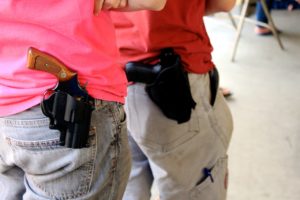Did the Dallas shooting that killed five police officers and injured several others reveal a flaw in the Texas open-carry law?
Consider what transpired during the Black Lives Matter march that turned violent when the shooter opened fire on the cops.
Several individuals were seen at the march carrying weapons in the open, which they were entitled to do under the state’s open-carry law. One young man was arrested, handcuffed and detained for some time while police investigated whether he took part in the shooting. It turns out he didn’t.
Which brings to mind the question: How do police determine who are the heat-packing bystanders in the heat of an adrenaline-filled moment in which tensions run at fever pitches?
Here’s a thought put forward by others, but which seem to make sense: The Texas Legislature ought to consider tweaking the open-carry law when it convenes in January to give cities the option of banning people from carrying weapons in the open during political demonstrations.
As the Beaumont Enterprise noted in an editorial, guns and political demonstrations just don’t mix.
I’ve been able to take part in simulated shooting demonstrations with the Amarillo Police Department. I can tell you from personal experience — and this involves use of weapons that did not carry live ammo — that the adrenaline that courses through one’s body in a shoot-don’t-shoot situation can cloud one’s judgment.
I cannot imagine the chaos that ensued in Dallas that evening when gunfire erupted. Police responded immediately to protect crowd members. Then some of them spotted spectators carrying weapons. What does a cop do — in an instant?
So, let’s fine-tune this law. If Texans are going to insist on the right to carry guns in the open, then there ought to be some reasonable restrictions on where they can pack them.
It seems quite reasonable to me to let cities decide whether to allow them at political rallies.
